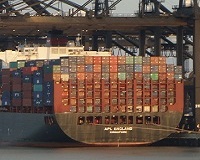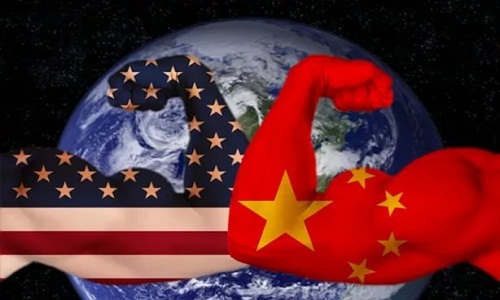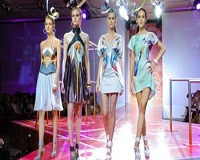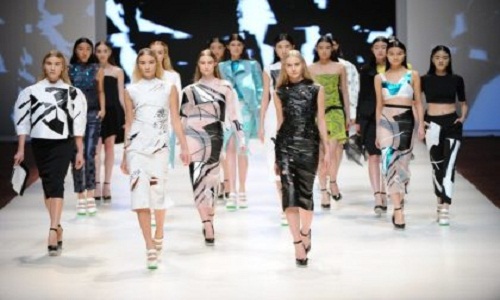FW
India’s apparel market is expected to grow by 11 to 12 per cent in the next seven years. The market grew at a compounded annual growth rate (CAGR) of 10 per cent from 2005 to 2017.
India’s domestic market has performed better than the largest consumption regions like the US, EU and Japan, where depressed economic conditions have led to lower demand and growth.
India’s apparel industry is dominated by the ready-to-wear category, which has a 84 per cent share and which is further growing at a CAGR of ten per cent to 11 per cent. The ready-to-stitch market is also gaining momentum as more and more men who have been buying premium or luxury readymade clothing brands want to wear a shirt or a trouser that fits them perfectly. The ready-to-stitch market is expected to grow at a CAGR of seven per cent till 2025.
However, apparel exports have taken a beating from October 2017 onwards. The introduction of the goods and services tax (GST) resulted in non-refund of several embedded taxes. Consequently, apparel exports for the financial year ’18 declined by four per cent from the previous year. The downturn continues this fiscal year with a month-on-month decline of ten per cent.
India has raised import duties on a large number of textile apparels, fibres and related products such as carpets by up to 20 per cent. Spread across 37 broad tariff areas, the import duties, however, target products for which India’s imports are low.
This includes textile apparels and accessories, hosiery items and certain types of vegetable based textile fibres, among others. Effective duty rate for most of these items have been doubled. Import duties had been increased for an even broader set of products and goods in the textile categories back in October 2017.
Interestingly, export of apparels, the largest chunk of exports within the textile segment, has been contracting since some months. Export of ready-made garments continued to drop in June, contracting by 12.34 per cent, albeit lower than the 16.62 per cent fall seen in May.
The Gujarat Garment Manufacturers Association (GGMA) fair will be held in Ahmedabad from July 19 to 21. The fair will see wholesale and retail buyers from across the country and abroad placing orders for upcoming festive season. The orders will give local manufacturers an idea about fashion trends and the demand from the market for the season.
However, unlike previous events, the mood this time is dampened. A shortfall of about 50 per cent in orders is expected as compared to the previous year. The overall slowdown in economy is taking a toll on business. But while the market for men’s wear may be slowing down, manufacturers of women’s wear and ethnic wear are bullish about the festive season. Optimism is based on the fact that women’s wear segment has a significant proportion of impulsive buying, which is not the case in men’s wear.
Over 260 manufacturers, representing close to 600 brands, will exhibit their products to over 18,000 buyers from states like Maharashtra, Rajasthan, Madhya Pradesh, Uttar Pradesh, Assam, West Bengal, Bihar, Orissa, Jharkhand, Chhatisgarh, Tamil Nadu, Andhra Pradesh, Karnataka and Kerala as well as from countries like Bangladesh, Sri Lanka and those of the Middle East.
A meeting between Uztekstilprom Association and Chinese ambassador to Uzbekistan noted Chinese investments into the textile industry of Uzbekistan has registered an increase and now exceeds $200 million.
The meeting discussed issues developments of cooperation between Uzbek and Chinese textile associations, large textile companies, expansion of investment activities of Chinese companies in Uzbekistan, increase in trade turnover between the countries, in particular, consideration of the issue of optimisation of rates of customs duties on the import of Uzbek textiles to China were discussed.
Particular emphasis was placed on the development of Chinese government's technical assistance program aimed at training and upgrading the skills of young specialists for the textile, clothing and knitting industries. During the period January-June 2018, within the framework of this program 15 specialists of the industry in different regions of China were trained.
As per Burberry’s 2017-18 annual report besides reporting an annual revenue of $3.61 billion, the brand also physically destroyed finished goods worth $37.8 million. These included ready-to-wear products and accessories.
Burberry is not the first brand to come under fire for destroying unsold items. As Quartz reported earlier this year, Richemont was actively buying-back and dismantling of its pricey timepieces, in an effort to “save their brand value,” at least in part from the tarnishment that comes from the grey market. Louis Vuitton has, for years, been plagued by reports that in order to avoid selling its well-known bags at a discount and risk tarnishing its image as a luxury leader, it burns its excess leather goods.
H&M was also accused of burning more than 3,483 pounds of clothing on one occasion last year, according to an investigation from Danish television channel TV2’s Operation X program.
Bangladesh is home to some of the world’s most environment-friendly apparel factories. The world’s highest-rated green denim, knitwear, washing and textile mills are all in Bangladesh. Of the top 11 LEED platinum-certified factories, eight are from Bangladesh. So far, 67 garment factories have achieved LEED certification. Of them, 17 are platinum rated and 37 are gold rated. Some 280 factories are under process for LEED certification.
The garment sector is accelerating its greening and becoming known for its sustainability initiatives. Bangladesh’s gross domestic product has grown steadily at six per cent in the past decade, with the last two years’ growth being around seven per cent.
Industrial share of the GDP is 29 per cent, and the lion’s share of that comes from the garment industry. The garment industry has about 4,000 active factories, employing 4.4 million workers, 80 per cent of whom are women. The sector has spawned backward and forward linkage industries. About 50 million Bangladeshis depend on the apparel sector for a living.
Globally Bangladesh is second only to China in apparel export volumes. Factory owners have invested in better working conditions. In the ’80s, sweatshop-like conditions and child labor were a sad reality. Now children are no longer employed in garment factories although child labor is prevalent in informal economic work.
The National Garment Fair organized by the Clothing Manufacturers Association of India (CMAI) was inaugurated by chief guest Kishore Biyani, Group CEO – Future Group at Bombay Exhibition Centre, NSE Complex, Goregaon (East), Mumbai. The fair is on in from July 16 to 19. This B2B fair is spread over 6,50,000 sq ft. There are 916 exhibitors in 986 stalls displaying 1087 brands in men’s wear, women’s wear, children’s wear and accessories.
Business networking sessions between exhibitors and agents and distributors, high street retailers, national chain stores and e-commerce companies would also continue this year. This year CMAI is also Celebrating 25 years of Association with Bombay Exhibition Centre. As per Rahul Mehta, President, MAI, India’s domestic apparel market was estimated at $67 billion in 2017 and had grown at a CAGR of 10 per cent since 2005. The market had performed better than the largest consumption regions like US, EU and Japan, where depressed economic conditions led to lower demand and growth. With strong fundamentals, the apparel market is expected to grow at 11-12 per cent CAGR and touch $160 billion by 2025.
"The US is looking to impose a new set of $200 billion tariffs on China. The move comes after the US implemented $34 billion worth of tariffs on Chinese imports recently, which was the first portion of the promised $50 billion Trump promised to levy against China over intellectual property concerns. Robert Lighthizer, US Trade Representative, stated China’s clap back was done without any international legal basis or justification. As a result of China’s retaliation and failure to change its practices, the president has ordered USTR (U.S. Trade Representative) to begin the process of imposing tariffs of 10 per cent on an additional $200 billion of Chinese imports. This is an appropriate response under the authority of Section 301 to obtain the elimination of China’s harmful industrial practices."
 The US is looking to impose a new set of $200 billion tariffs on China. The move comes after the US implemented $34 billion worth of tariffs on Chinese imports recently, which was the first portion of the promised $50 billion Trump promised to levy against China over intellectual property concerns. Robert Lighthizer, US Trade Representative, stated China’s clap back was done without any international legal basis or justification. As a result of China’s retaliation and failure to change its practices, the president has ordered USTR (U.S. Trade Representative) to begin the process of imposing tariffs of 10 per cent on an additional $200 billion of Chinese imports. This is an appropriate response under the authority of Section 301 to obtain the elimination of China’s harmful industrial practices.
The US is looking to impose a new set of $200 billion tariffs on China. The move comes after the US implemented $34 billion worth of tariffs on Chinese imports recently, which was the first portion of the promised $50 billion Trump promised to levy against China over intellectual property concerns. Robert Lighthizer, US Trade Representative, stated China’s clap back was done without any international legal basis or justification. As a result of China’s retaliation and failure to change its practices, the president has ordered USTR (U.S. Trade Representative) to begin the process of imposing tariffs of 10 per cent on an additional $200 billion of Chinese imports. This is an appropriate response under the authority of Section 301 to obtain the elimination of China’s harmful industrial practices.
Textiles, cotton part of list
This time, the list which stretches on for 195 pages of the USTR’s report, includes the bulk of what consumers would buy in the supermarket plus much of the raw materials that go into what they would buy to wear. Cotton and ancillaries such as cotton yarn, cotton sewing thread, cotton woven fabric, and cotton waste will face new 10 per cent tariffs for companies that want to bring in the goods from China. Nylon yarn, polyester yarn, viscose, jute, hemp and pulps of cellulosic material are also on the list, plus coconut and other vegetable fibers companies are now turning to be as sustainable raw material alternatives. Woven fabrics across most raw materials, nonwovens, terry fabrics, lace, tulle and leather are on the target list. Apparel and clothing accessories made of plastic, vulcanised rubber, furskins and cellulose fibre will also face the new tariffs. As far as accessories, handbags, sports bags and travel goods, like suitcases and vanity cases, will face new tariffs. For footwear, there will be tariffs on shoelaces, hooks and eyelets and polishes for leather shoes. Additionally, brands and retailers will pay for finishing and sending off garments too, with garment labels, folding cartons, boxes and packing containers on the list.
would buy in the supermarket plus much of the raw materials that go into what they would buy to wear. Cotton and ancillaries such as cotton yarn, cotton sewing thread, cotton woven fabric, and cotton waste will face new 10 per cent tariffs for companies that want to bring in the goods from China. Nylon yarn, polyester yarn, viscose, jute, hemp and pulps of cellulosic material are also on the list, plus coconut and other vegetable fibers companies are now turning to be as sustainable raw material alternatives. Woven fabrics across most raw materials, nonwovens, terry fabrics, lace, tulle and leather are on the target list. Apparel and clothing accessories made of plastic, vulcanised rubber, furskins and cellulose fibre will also face the new tariffs. As far as accessories, handbags, sports bags and travel goods, like suitcases and vanity cases, will face new tariffs. For footwear, there will be tariffs on shoelaces, hooks and eyelets and polishes for leather shoes. Additionally, brands and retailers will pay for finishing and sending off garments too, with garment labels, folding cartons, boxes and packing containers on the list.
China’s Ministry of Commerce said it is totally unacceptable for the US to publish the tax collection list in an accelerated upgrade. The behaviour of the US is hurting China, hurting the world, and hurting itself. This irrational behaviour is unpopular. In order to safeguard the core interests of the country and the fundamental interests of the people, the Chinese Government will, as always, have to make the necessary countermeasures.
Associations’ reactions
Rick Helfenbein, president and CEO, American Apparel & Footwear Association, said this will result in inflationary costs throughout the supply chain, ultimately paid for by the American consumer. With more than 84 per cent of US travel goods coming from China, this will hurt enormously. With the inclusion of virtually all fibres, yarn and fabric tariff lines, NCTO’s response will be on a line-by-line base, with support or opposition to individual lines dependent on how the competitiveness of the US textile industry is impacted.
On the other hand, David French, senior vice president for government relations, National Retail Federation, argued that the administration has been pursuing tariffs now for months. The latest $200 billion of products to be subject to tariffs against China doubles down on a reckless strategy that will boomerang back to harm US families and workers. French added that tariffs on such a broad scope of products make it inconceivable that American consumers will dodge this tax increase as prices of everyday products will be forced to rise. And the retaliation that will follow will destroy thousands of US jobs and hurt farmers, local businesses and entire communities. USTR says, any merchandise subject to the increased tariffs admitted into a US foreign trade zone on or after the effective date of the increased tariffs…would be subject upon entry for consumption to the additional duty.
"Organised by the Hong Kong Trade Development Council (HKTDC), the 25th Hong Kong Fashion Week Spring/Summer ended recently. The four-day fair held from July 9-12, 2018 attracted around 11,000 buyers from 65 countries and regions. The participating countries included: Bangladesh, India, Indonesia, Malaysia, Russia, Thailand and Vietnam recorded considerable growth. Around 15 fashion events, including fashion shows, industry forecasting and fashion tech seminars, a buyer forum and a networking reception were held during the fair to generate business opportunities for industry professionals."
 Organised by the Hong Kong Trade Development Council (HKTDC), the 25th Hong Kong Fashion Week Spring/Summer ended recently. The four-day fair held from July 9-12, 2018 attracted around 11,000 buyers from 65 countries and regions. The participating countries included: Bangladesh, India, Indonesia, Malaysia, Russia, Thailand and Vietnam recorded considerable growth. Around 15 fashion events, including fashion shows, industry forecasting and fashion tech seminars, a buyer forum and a networking reception were held during the fair to generate business opportunities for industry professionals.
Organised by the Hong Kong Trade Development Council (HKTDC), the 25th Hong Kong Fashion Week Spring/Summer ended recently. The four-day fair held from July 9-12, 2018 attracted around 11,000 buyers from 65 countries and regions. The participating countries included: Bangladesh, India, Indonesia, Malaysia, Russia, Thailand and Vietnam recorded considerable growth. Around 15 fashion events, including fashion shows, industry forecasting and fashion tech seminars, a buyer forum and a networking reception were held during the fair to generate business opportunities for industry professionals.
As Benjamin Chau, Deputy executive Director, HKTDC said, “The global economy is now facing significant challenges, with the impact of the Sino-US trade friction. Hong Kong companies should stay competitive by launching diversified products and designs, and by exploring emerging markets. Besides participating in trade fairs, they should also engage in promotions with online sourcing platforms and social media, to reach more global buyers.”
challenges, with the impact of the Sino-US trade friction. Hong Kong companies should stay competitive by launching diversified products and designs, and by exploring emerging markets. Besides participating in trade fairs, they should also engage in promotions with online sourcing platforms and social media, to reach more global buyers.”
Fashion and technology have merged and formed a new trend in recent years, where more and more innovative technologies are incorporated in fashion design, manufacturing, sourcing and sales. During the fashion week, HKTDC organised seminars such as 'The Next Wave in Fashion Technology' and 'Online Shopping Reshapes the Fashion Industry' so as to discuss the latest fashion tech applications and explore marketing strategies for online fashion sales, offering useful insights for both exhibitors and buyers. ‘The next wave in fashion industry’ seminar session explored wearable tech in thermostatic clothing and how to get the accurate shapes and sizes using smart 3D human modelling technology.
On-site orders received
The four-day fair brought latest market intelligence and fashion tech to buyers and created many sourcing opportunities for the industry. Mohamed Sadhique, a buyer from UAE’s Lamia Garments Manufacturing, said it was his second visit to the fair to source laces and other fabrics. He had already placed on-site orders with two suppliers from Hong Kong and the Chinese mainland. The orders from Hong Kong supplier were worth about $250,000, while the order from Chinese mainland supplier was around $45,000.” He said Hong Kong is an excellent place to source fabrics and expects to develop business with more new suppliers for a mix of laces and fabrics.
Variety of products on display
The Hong Kong exhibitor MsEnvy has been displaying at the fair for many years and leveraged the platform to launch an array of silk womenswear each year to capture buyers’ attention. This year, the company offered womenswear with 300 styles to buyers. Jun MK Wong, MD, MsEnvy, said that a number of new customers including buyers from Canada, Japan, Singapore and other Southeast Asian countries showed interest in their designs. A new buyer from Italy was keen on purchasing some styles in silk and polyester, and the order was expected to be finalised within three to six months. She also pointed out existing customers from Italy and Australia returned to make new orders, while the company has established cooperation with another new Australian company to develop new collections.
To cater to the demand for sourcing in small amounts, the show once again set up the hktdc.com Small Orders zone, featuring nearly 100 showcases and garment racks with close to 300 products, which are available for orders in minimum quantities of between five and 1,000 pieces. During the four-day event, 2,700 buyers visited the zone and 6,000 connections were established. The third edition of CENTRESTAGE, a platform for international, especially Asian fashion brands and designers to promote their brands and launch their collections, will be held September 5-8, 2018.
Kenya is planning to modernise Rivatex factories and adopt high-yielding seeds to revive the ailing cotton sector. Through this upgrade, whose cost will add up to Sh3 billion by the end of the year, the textile firm plans to spur production from the current 1 tonne of lint, equivalent to 6,000 metres, to over 12 tonnes or 40,000 metres of finished products in a day.
Rivatex currently consumes 10 bales of cotton daily, but this is expected to increase to 70 bales once modernisation of equipment is complete. Kenya wants to take advantage of global markets with the African Growth and Opportunity Act (AGOA) to change the fortunes of the sector. Under AGOA, goods of more than 6,000 product lines, mainly textile and apparel, accounting for 65 per cent of the total exports, are granted quota and duty-free access to the US market.











